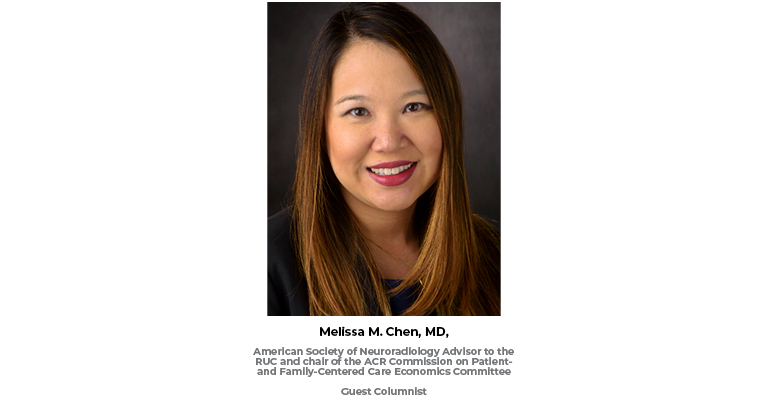Advances in medicine, such as use of endovascular therapy for treatment of acute ischemic stroke, have dramatically changed outcomes for patients with improved morbidity and mortality. Diagnostic imaging exams, such as CT angiogram head and CT angiogram neck, play a central role in promptly triaging these patients for appropriate care — improving the value radiologists provide to patients. Unfortunately, an unintended consequence of this change in practice could result in the code being identified as potentially misvalued by the AMA/Specialty Society RVS Update Committee (RUC).
Many are familiar with the work that the RUC undertakes in the valuation of new CPT® codes and revaluation of procedures we perform as physicians. A process less familiar is how the RUC identifies what it terms potentially misvalued codes. The knowledge of this process is important in understanding and anticipating which codes may be flagged for revaluation in the future.
In response to criticism from the Medicare Payment Advisory Commission and the U.S. Government Accountability Office, the RUC established a workgroup called the Five-Year Identification Workgroup in 2006 — since renamed the Relativity Assessment Workgroup (RAW). The RAW was charged with identifying potentially misvalued services. The work of this group was further catalyzed by the Patient Protection and Affordable Care Act of 2010, which required the Secretary of Health and Human Services to “periodically identify services as being potentially misvalued,” and stated that the Secretary may consolidate “individual codes into bundled codes for payment.”1
The RAW and CMS developed criteria for identifying potentially misvalued services, such as new technology screens, site-of-service anomalies, or high growth. One of these criteria includes a screen to find “reported together” services. When services are performed together, CMS and the RUC believe that resource efficiencies gained may have impact on the valuation, or relative value unit (RVU). When the screen was initially created, services performed by the same physician on the same date of service were bundled under the same CPT code 95% of the time. This 95% threshold resulted in the deletion of 31 individual codes and the creation of 53 new codes that described the bundle of services.2
One radiology exam impacted by this screen was CT abdomen/pelvis. Previously, CT abdomen and CT pelvis were separate CPT codes, reportable as six different codes depending on the absence and/or presence of IV contrast. The CPT Editorial Panel restructured the “family of codes,” when exams are reported together, to three separate codes: CT abdomen/pelvis without IV contrast, CT abdomen/pelvis with IV contrast, and CT abdomen/ pelvis without and with IV contrast. CT abdomen and CT pelvis codes are available when performed alone.
The knowledge of this process is important in understanding and anticipating which codes may be flagged for revaluation in the future.
The CT abdomen/pelvis code family was subsequently revalued in the RUC process and resulted in an overall decrease in valuation. As an example, the professional RVU for CT abdomen/pelvis with IV contrast is 27% less than it was when it was previously reported as two separate CPT codes.3
In February 2010, the RAW lowered the threshold to services that reported 75% or more together. Since then, the RAW has performed five cycles of analysis of code pairs reported together using the 75% threshold. The last cycle started in October 2017, and the RUC submitted its recommendations for the 2020 and 2021 Medicare Physician Fee Schedule. Many IR codes were captured in the “reported together” screens and were subsequently bundled together, resulting in downward revisions in reimbursement.
CT angiogram head and CT angiogram neck are two separate CPT codes, not previously identified on “reported together” screens because this practice did not meet the 75% threshold at the time of the last screen in 2017. However, now these exams are commonly being ordered together in large volumes to appropriately triage stroke patients and will likely meet or exceed the 75% threshold. This would trigger the codes to be revised by the CPT Editorial Panel — to be bundled together and then revalued by the RUC. While this has not yet occurred, we anticipate it may happen soon.
The work of the ACR Commission on Economics, in concert with the RUC and CPT teams, will remain important to advocate for appropriate valuation of the valuable work we do as radiologists.

